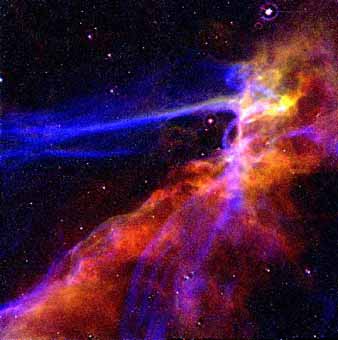![]()
![]()
Postscript - Montgomery's 'Cygnus Event'

The March 2006 issue of ASTRONOMY NOW cites the findings of British anthropological writer Denis Montgomery. In 1995 he proposed that high levels of Beryllium-10 in the Antarctic and Greenland ice cores for a period of 2,000 years, c. 35,000 BP, argue that sudden transitions in human behaviour patterns around this time show that the two events are not exclusive to each other. Most obviously, the flowering of cave art in Western Europe, c. 32,500-30,000 BP, is a clear sign that something quite extraordinary was taking place (and, of course, c. 17,000-14,000 BP, when further high levels of Be-10 are present in the same ice cores).
|
Based on suggestions made by American and Russian scientists working on the Greenland and Antarctica ice cores at the beginning of the 1990s, Montgomery proposed that the source of the cosmic rays was a close supernova, most likely the one that caused the beautiful stellar debris caught on camera by the Hubble space telescope and known to astronomers as the Cygnus Veil, or Cygnus Loop. Located in the right wing of the celestial swan, the shock waves of this cosmic event were believed to have ripped open the Earth's protective layer of ozone, causing cosmic rays and ultraviolet radiation from the sun to rain down on the unsuspecting world beneath. For many years the exploding star would have been brighter than the full moon, making it a blinding light source that turned night into day. Premature deaths, cancer and mutations would have resulted in both animals and humans on a massive scale. Yet very gradually the supernova would have burnt out, and an immunity achieved by the human survivors, our own Homo sapien ancestors, who were the successors of the less adaptable Neanderthal peoples. |
Cygnus Loop supernova blast
wave. |
Even though the 35,000 BP cosmic event highlighted by the Be-10 levels in the ice cores alluded to Montgomery is the same as the one proposed by the Meinel Institute, said by them to have taken place c. 40,000 years ago, the suspected source of the cosmic rays is unlikely to have been the Cygnus Veil, or Loop. This is now known to have been created when a dying super giant in this suspected binary system exploded into a supernova just 5,000 to 8,000 years ago. Moreover, at worst this spectacular event, which would have temporarily made it one of the brightest sources in the night sky, was far too distant to have affected life on Earth.
This reassessment of the Cygnus Veil comes from revised data regarding its distance, now thought to be around 1,400 light years away, instead of the presupposed 150 light years banded around in the early 1990s. Moreover, no other similar event is known to have occurred around 35,000-40,000 years ago, even though close supernovae cannot be ruled out as the cause of mass extinctions on Earth, either in the past or in the future.
Having now spoken at length with Denis Montgomery on his proposed 'Cygnus event', and explained to him the latest data regarding the Cygnus Veil, he has now revised his two electronic books (available at www.sondela.co.uk/Aqua/Books/AquaApeA4.pdf, and faculty.mdc.edu/jmcnair/EveA4.pdf) to include other possible sources of cosmic rays that might have irradiated the Earth in Palaeolithic times, including Cygnus X-3.
The Meinels, although now acknowledging Cygnus X-3 as a proposed source of cosmic rays reaching the earth, have dismissed my claims in favour of the Cat's Eye nebula. However, these criticisms are fully addressed in a paper I have written entitled 'In defence of Cygnus X-3 as a Cosmic Accelerator: Response to Criticisms regarding its Production of Neutral Particles with Energies up to PeV', available HERE
Despite some questions arising from his overall theory, Denis Montgomery must be credited for having pioneered the idea of cosmic rays influencing human evolution, and for concluding that its point source was in the Cygnus region, a road which he admits has been a long and often solitary one.
![]()
![]()
